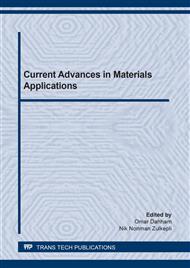[1]
W. N. Al-Rifaie and W. K. Ahmed, Effect of Nanomaterials in Cement Mortar Characteristics, Journal of Engineering Science and Technology, 11, (2016) 1321 – 1332.
Google Scholar
[2]
S Sanju, S Sharadha and J Revathy, Performance on The Study of Nano Materials for The Development of Sustainable Concrete, International Journal of Earth Science and Engineering, 09 (2016) 294-300.
Google Scholar
[3]
S.P. Kanniyappan, S.SaravanaKumar, T.Muthukumaran, Analyzing the Microstructural Properties of Nanomaterial in OPC by SEM, TEM, XRD and Corrosion Rate by TAFEL Techniques, International Research Journal of Engineering and Technology, 04 (2017) 1497-1503.
Google Scholar
[4]
H. Li, H.G. Xio, J. Yuan, J. Ou, Microstructure of Cement Mortar With Nano Particles", Composite Engineering, 35 (2004) 185-189.
Google Scholar
[5]
D. Trejo and K. Acosta, Influence of ZrO2 Nanoparticles on the Microstructural Development of Cement Mortars with Limestone Aggregates, Applied Science Journal, 2019, https//.
DOI: 10.3390/app9030598
Google Scholar
[6]
L. Wang, D. Zheng, S. Zhang, H. Cui and D. Li, Effect of Nano-SiO2 on the Hydration and Microstructure of Portland Cement, Nanomaterials 6 (2016) 241.
DOI: 10.3390/nano6120241
Google Scholar
[7]
M. R. Arefi, M. R. Javeri, E. Mollaahmadi, To study the effect of adding Al2O3 nanoparticles on the mechanical properties and microstructure of cement mortar, Life Science Journal 8(2011) http://www.sciencepub.net/life.
Google Scholar
[8]
Iraqi Standard Specifications No. 5, Portland Cement,, Central Organization for Standardization and Quality Control, Iraq, (1984).
Google Scholar
[9]
Iraqi Standard Specifications No.2080, Portland Cement,, Central Organization for Standardization and Quality Control, Iraq, (1998).
Google Scholar
[10]
ASTM C 1240 – 05, Standard Specification for Silica Fume Used in Cementitious Mixtures,, ASTM, West Conshohocken, PA, USA, (2005).
Google Scholar
[11]
ASTM C 1437, Standard Test Method for Flow of Hydraulic Cement Mortar,, ASTM International, West Conshohocken, (2007).
Google Scholar
[12]
ASTM C 183– 02, Standard Practice for Sampling and the Amount of Testing of Hydraulic Cement,, ASTM, West Conshohocken, PA, USA, (2002).
Google Scholar
[13]
ASTM C 109/C 109M , Standard Test Method for Compressive Strength of Hydraulic Cement Mortars,, ASTM, West Conshohocken, PA, USA, (2002).
Google Scholar
[14]
A. Al Ghabban, A. B. Al Zubaidi, and Z. Fakhri, Pozzolanic activity and durability of nano silica, micro silica and silica gel contained Concrete, AIP Conference Proceedings 1968 (2018) 030019.
DOI: 10.1063/1.5039206
Google Scholar
[15]
V.A. Khomich, S.A. Emralieva, M.V. Tsyguleva, Nanosilica modifiers for cement mortars Procedia Engineering 152 (2016) 601-607.
DOI: 10.1016/j.proeng.2016.07.662
Google Scholar
[16]
A. Nazari and S. Riahi, The Effects of ZrO2 Nanoparticles on Physical and Mechanical Properties of High Strength Self Compacting Concrete, Materials Research, 13, (2010) 551-556.
DOI: 10.1590/s1516-14392010000400019
Google Scholar
[17]
Z. Wu, C. Shi, K.H. Khayat, S. Wan, Effects of different nanomaterials on hardening and performance of ultra-high strength concrete (UHSC). Cement and Concrete Composites, 70 (2016) 24–34.
DOI: 10.1016/j.cemconcomp.2016.03.003
Google Scholar
[18]
M. Kantharia, P. Mishra, M.K. Trivedi, Strength of Cement Mortar Using Nano Oxides: An Experimental Study, International Journal of Engineering and Advanced Technology, 8 (2016) 294-299.
Google Scholar
[19]
P. Narasimha Reddy and J. Ahmed Naqash, Experimental Study on TGA, XRD and SEM Analysis of Concrete with Ultrafine Slag, International Journal of Engineering, 32 (2019) 679-684.
Google Scholar
[20]
NK.Dhapekar, A.S. Majumdar and P.K. Gupta, Study of phase composition of Ordinary Portland Cement Concrete using X-Ray Diffraction, International Journal of Scientific & Engineering Research, 6 (2015) 433- 440.
Google Scholar
[21]
Y. Su, C. Wu, J. Li, Z. X. Li and W. Li, Development of Novel Ultra High Performance Concrete: From Material to Structure, Construction and Building Materials, 135 (2017) 517-528.
DOI: 10.1016/j.conbuildmat.2016.12.175
Google Scholar
[22]
F.U.A. Shaikh and A. Hosan, Effect of Nano Alumina on Compressive Strength and Microstructure of High Volume Slag and Slag-Fly Ash Blended Pastes, Frontiers in Materials, 6 (2019),.
DOI: 10.3389/fmats.2019.00090
Google Scholar


